Abstract
1. The present investigation was designed to examine human adaptation to intermittent severe cold exposure and to assess the effect of exercise on any adaptation obtained. 2. Sixteen subjects were divided into two equal groups. Each subject performed ten head-out immersions; two into thermoneutral water which was then cooled until they shivered vigorously, and eight into water at 15 degrees C for 40 min. During the majority of the 15 degrees C immersions, one group (dynamic group) exercised whilst the other (static group) rested. 3. Results showed that both groups responded to repeated cold immersions with a reduction in their initial responses to cold. The time course of these reductions varied, however, between responses. 4. Only the static group developed a reduced metabolic response to prolonged resting immersion. 5. It is concluded that repeated resting exposure to cold was the more effective way of producing an adaptation. The performance of exercise during repeated exposure to cold prevented the development of an adaptive reduction in the metabolic response to cold during a subsequent resting immersion. In addition, many of the adaptations obtained during repeated resting exposure were overridden or masked during a subsequent exercising immersion.
Full text
PDF
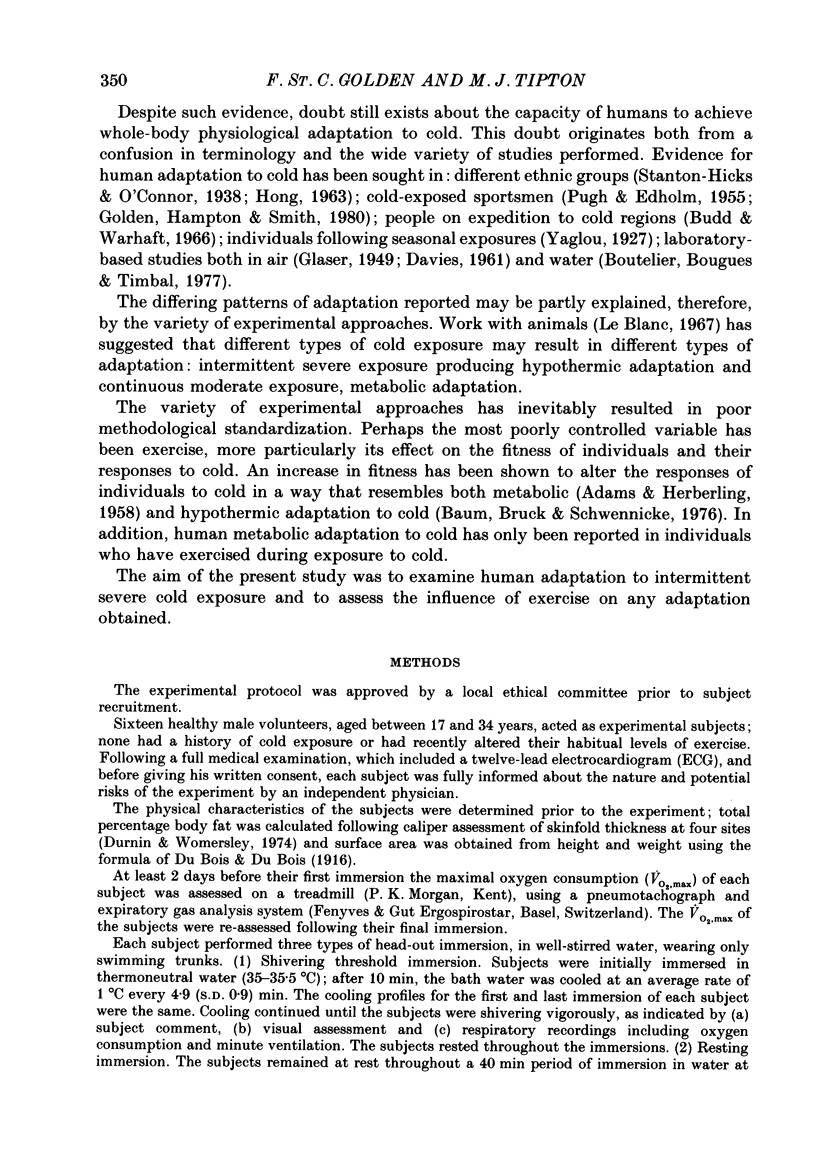
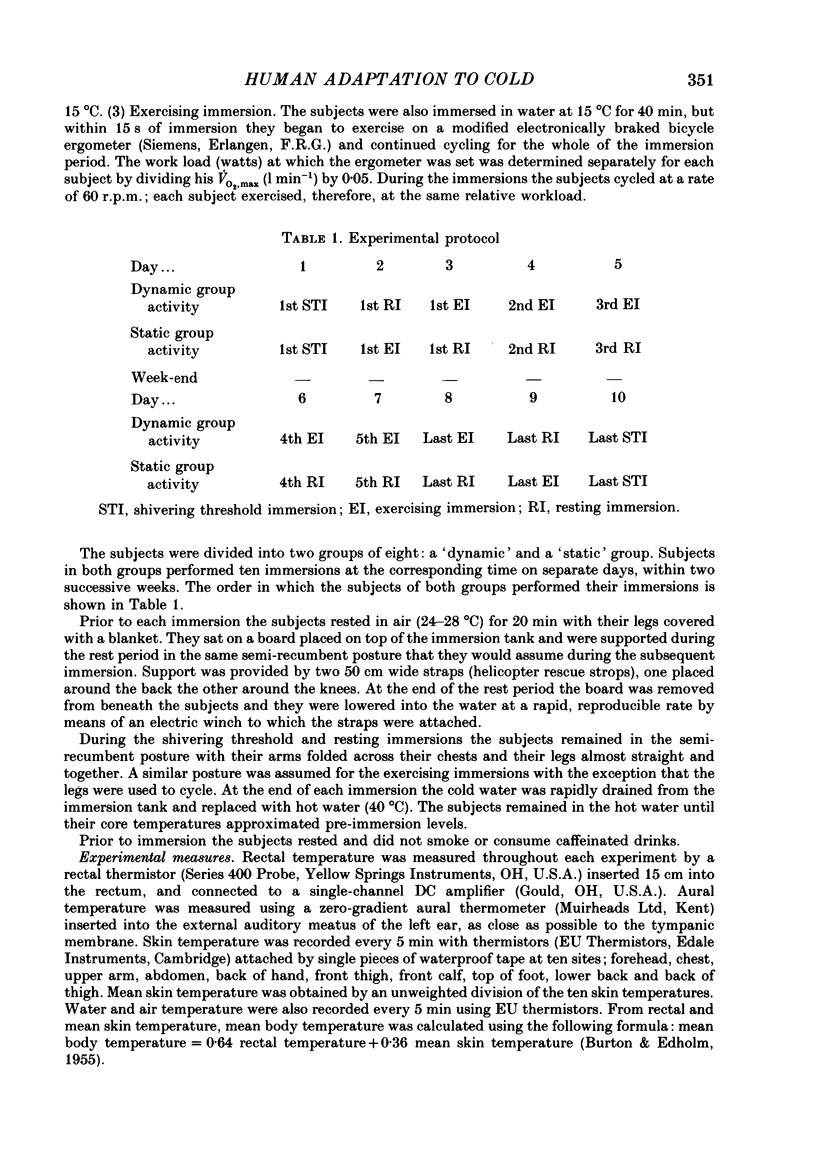
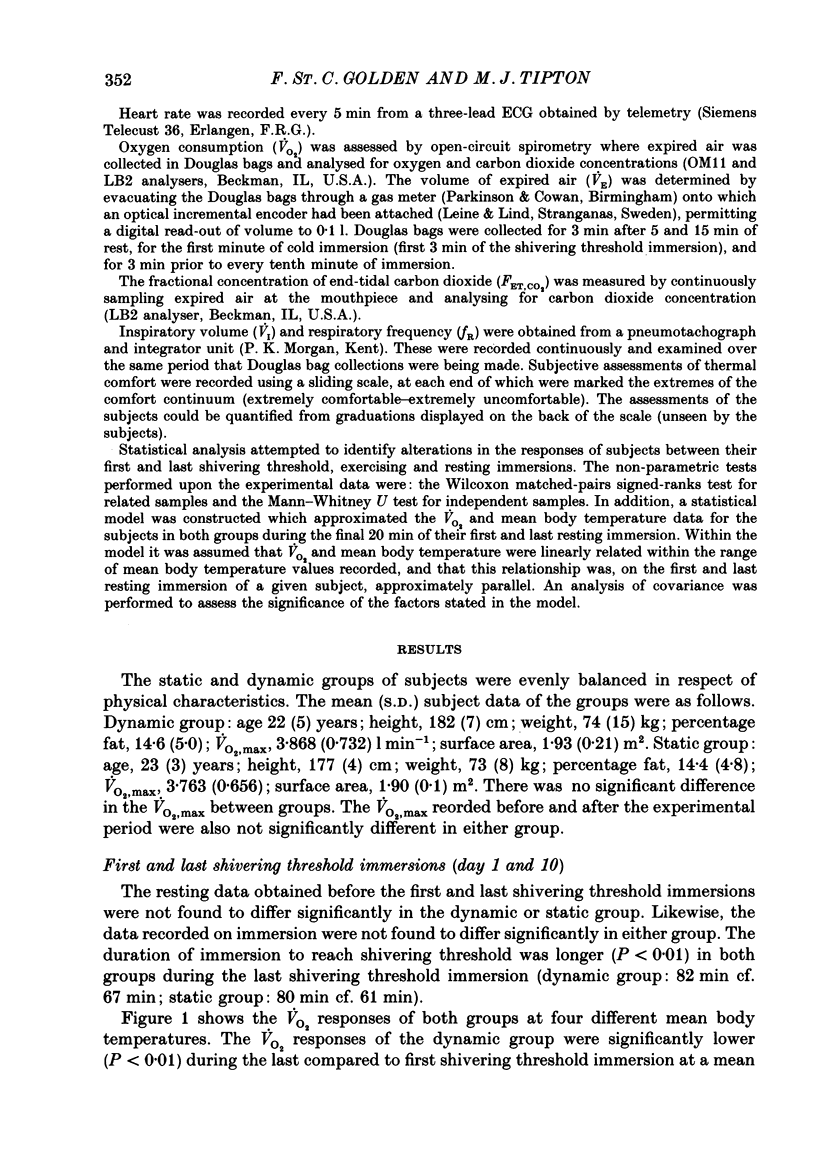
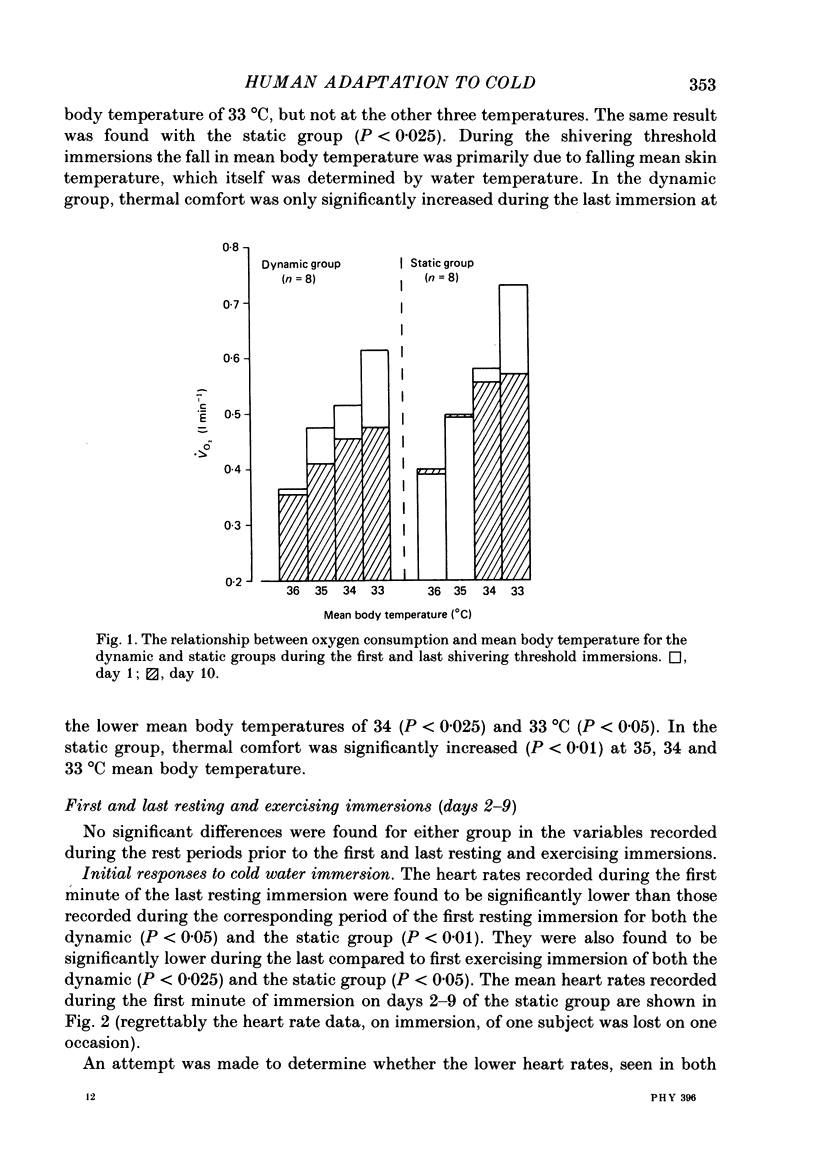
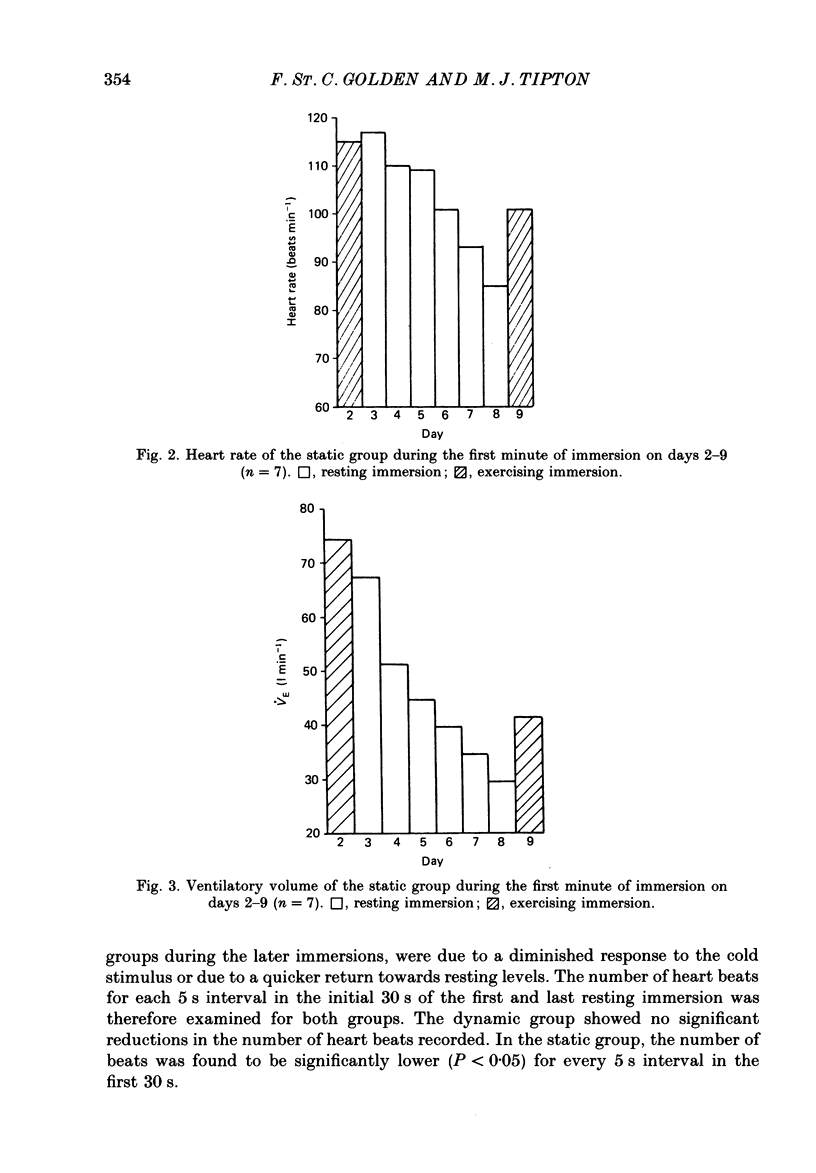

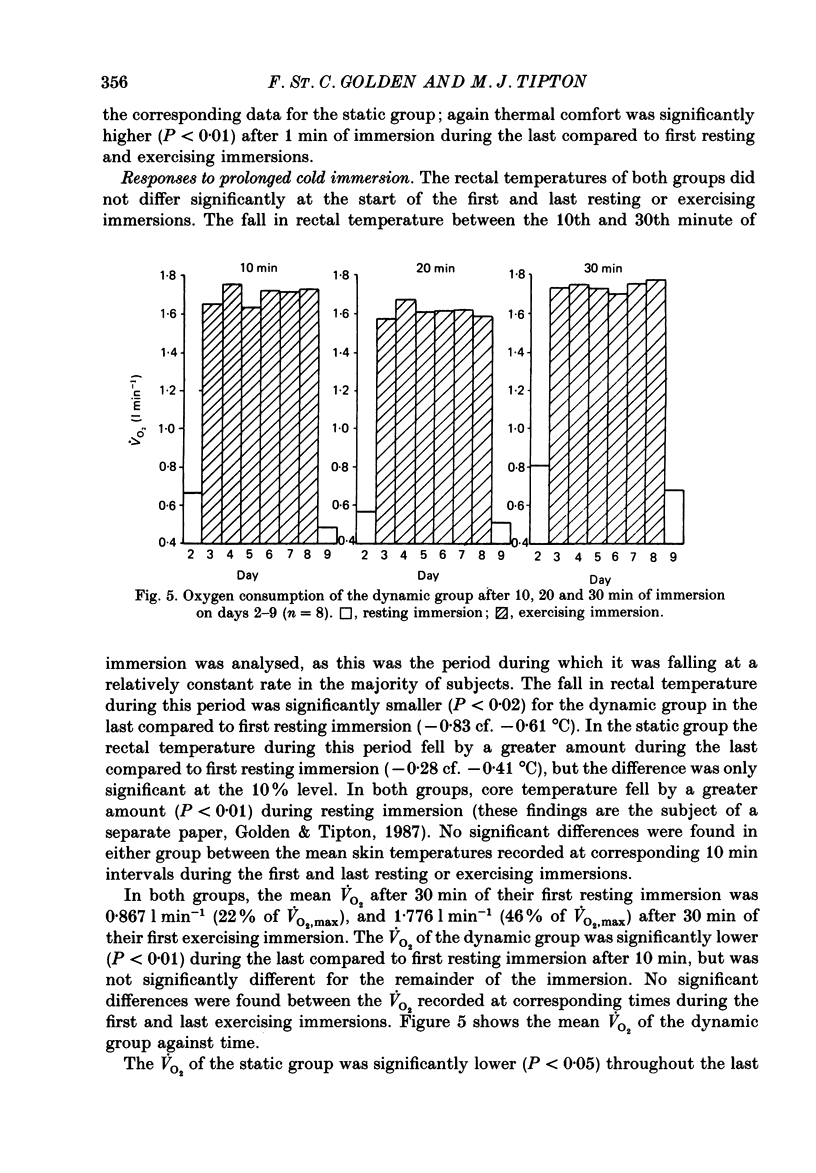
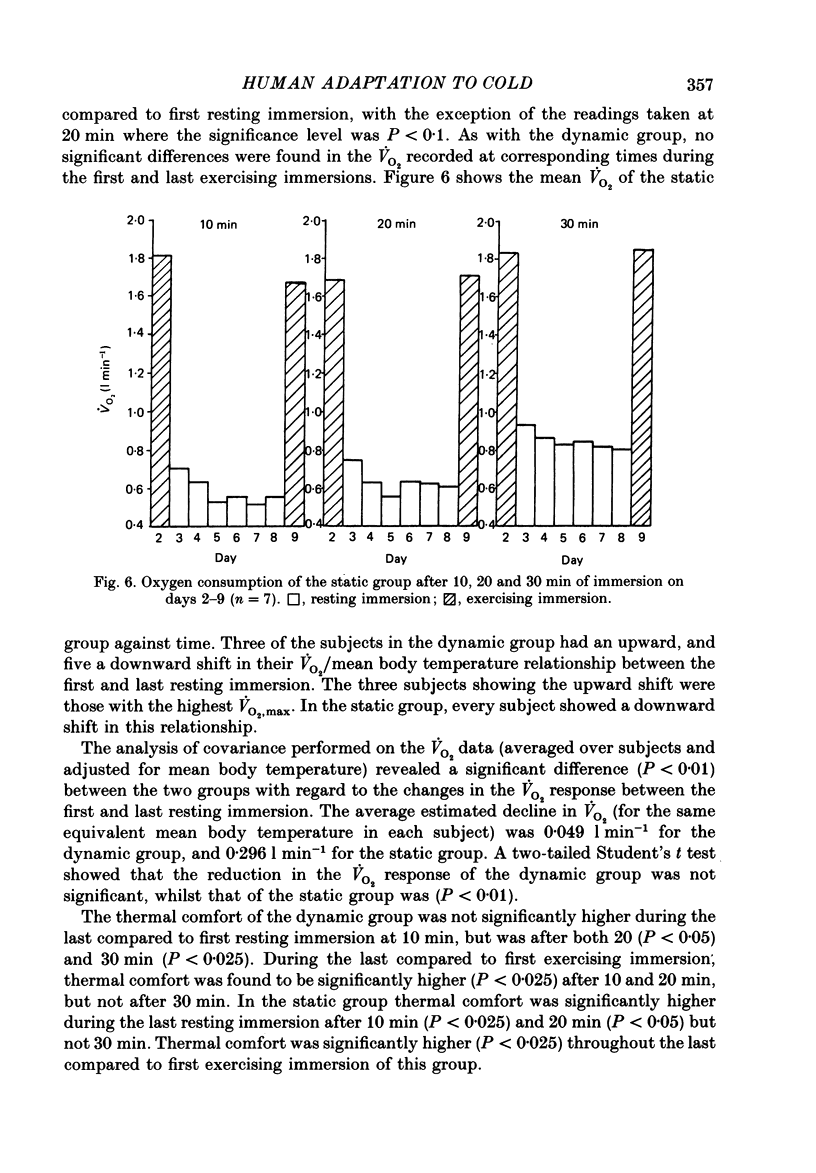

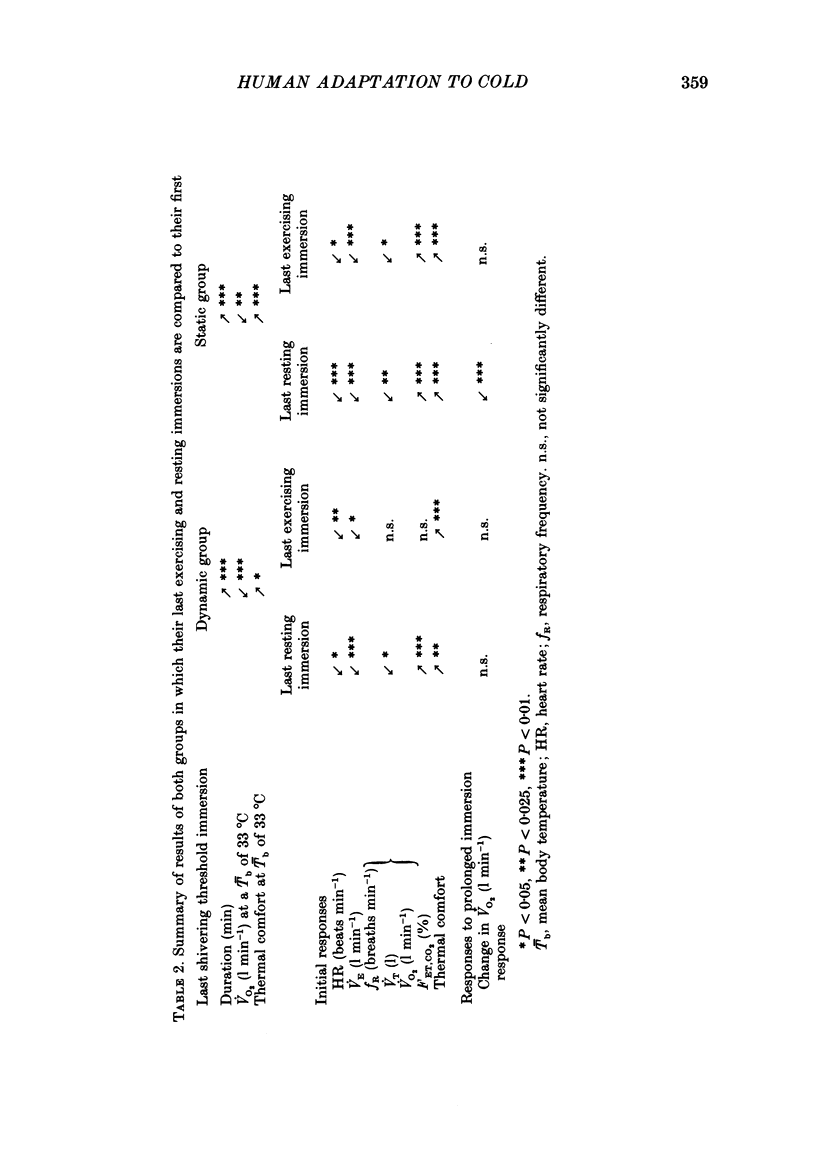

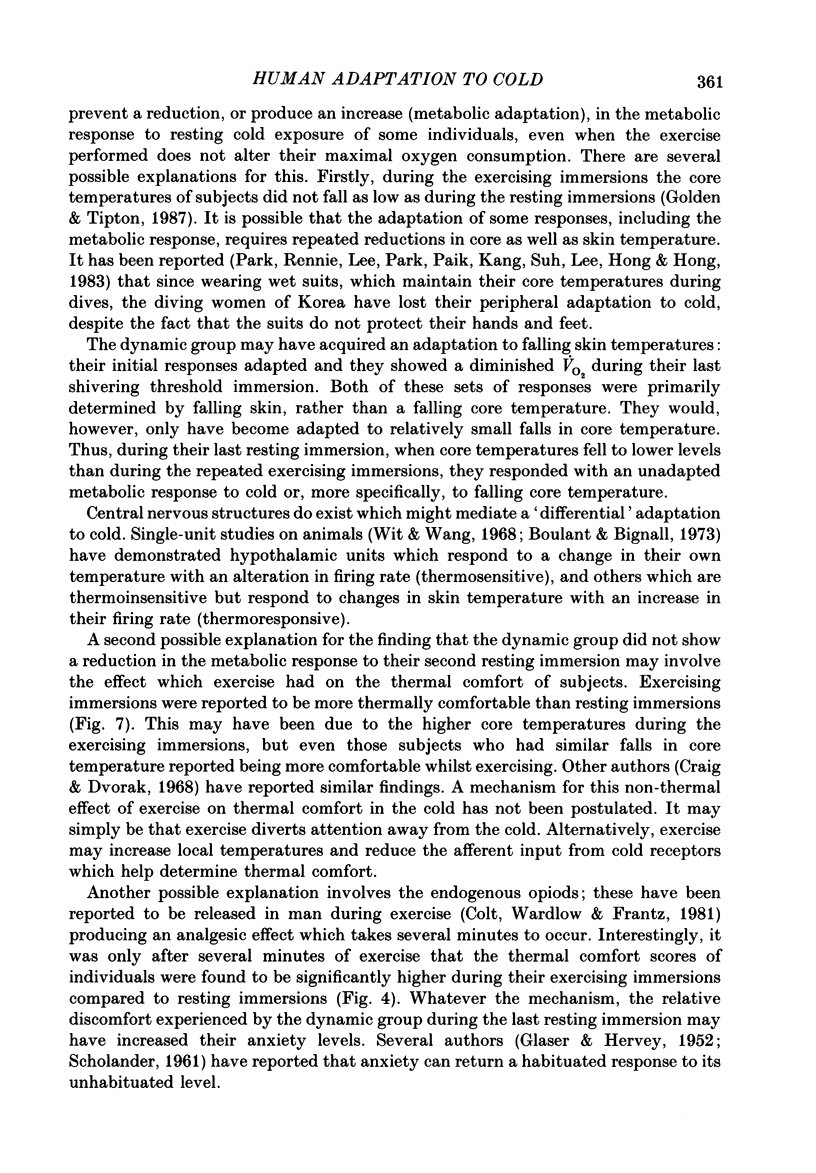
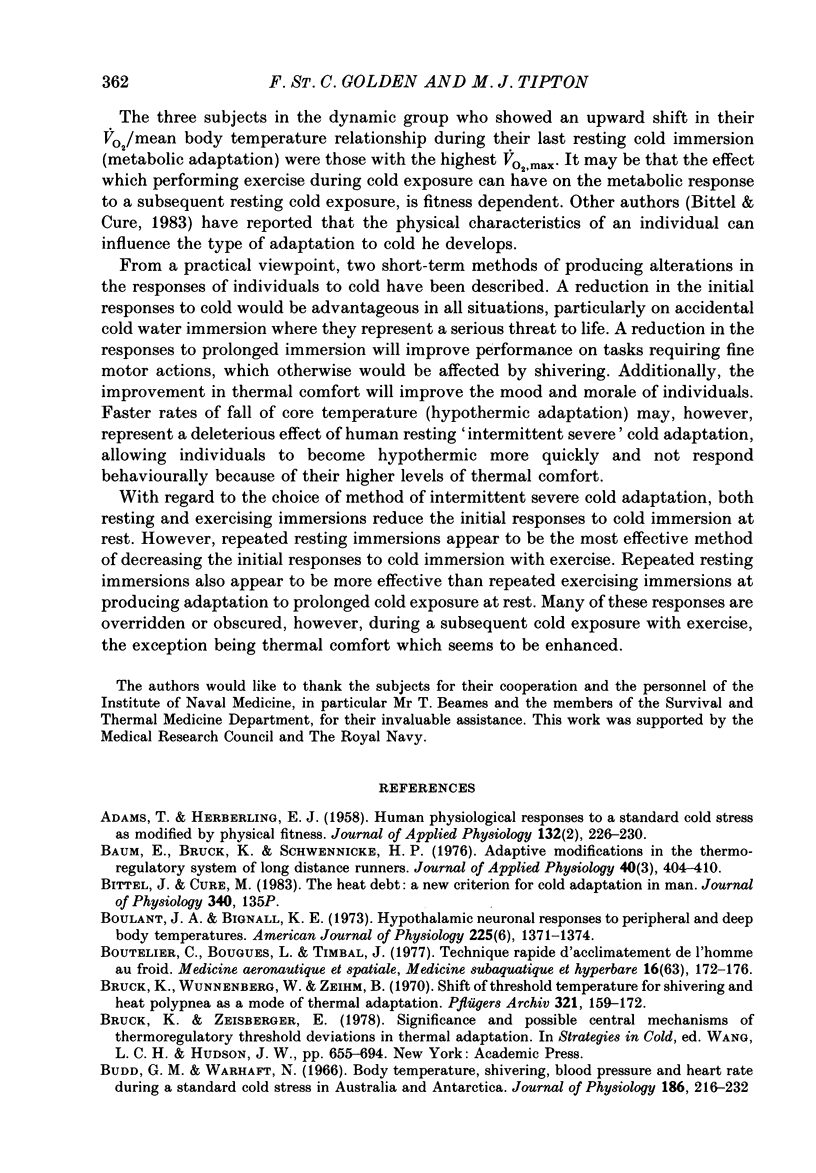
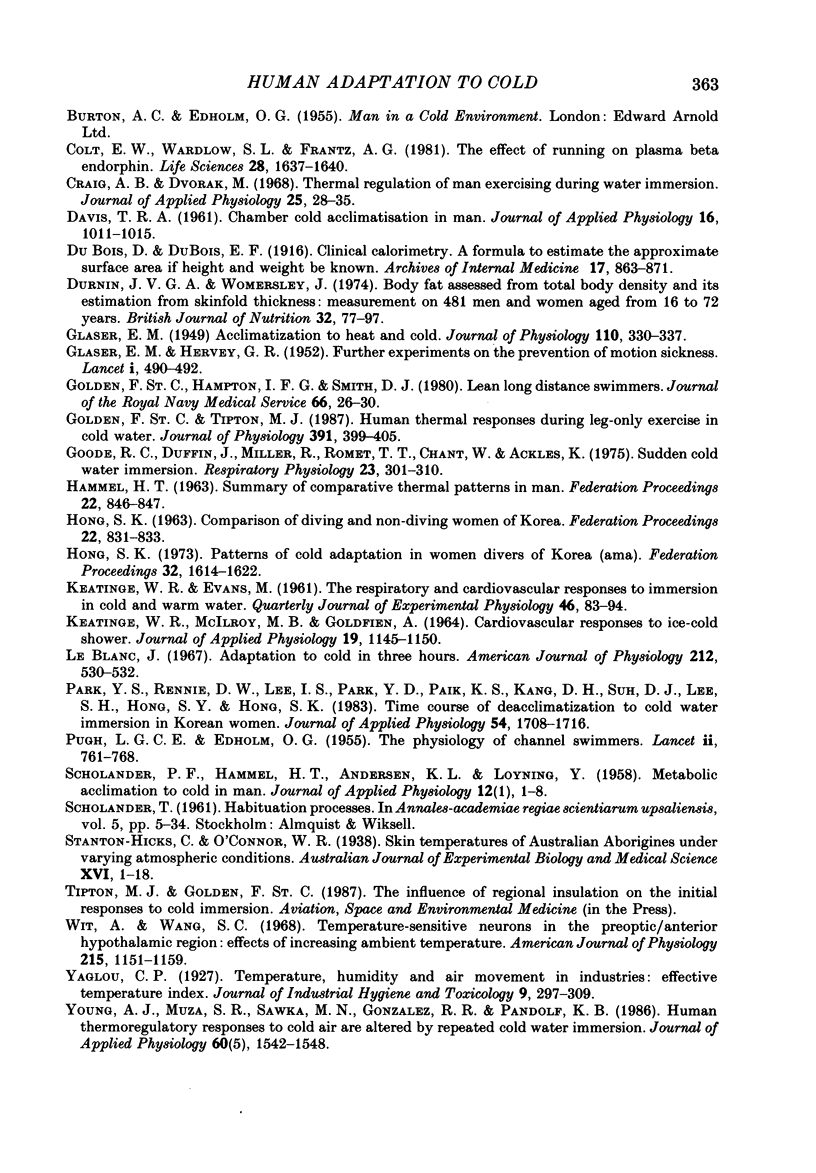
Selected References
These references are in PubMed. This may not be the complete list of references from this article.
- ADAMS T., HEBERLING E. J. Human physiological responses to a standardized cold stress as modified by physical fitness. J Appl Physiol. 1958 Sep;13(2):226–230. doi: 10.1152/jappl.1958.13.2.226. [DOI] [PubMed] [Google Scholar]
- Baum E., Brück K., Schwennicke H. P. Adaptive modifications in the thermoregulatory system of long-distance runners. J Appl Physiol. 1976 Mar;40(3):404–410. doi: 10.1152/jappl.1976.40.3.404. [DOI] [PubMed] [Google Scholar]
- Boulant J. A., Bignall K. E. Hypothalamic neuronal responses to peripheral and deep-body temperatures. Am J Physiol. 1973 Dec;225(6):1371–1374. doi: 10.1152/ajplegacy.1973.225.6.1371. [DOI] [PubMed] [Google Scholar]
- Brück K., Wünnenberg W., Gallmeier H., Ziehm B. Shift of threshold temperature for shivering and heat polypnea as a mode of thermal adaptation. Pflugers Arch. 1970;321(2):159–172. doi: 10.1007/BF00586370. [DOI] [PubMed] [Google Scholar]
- Budd G. M., Warhaft N. Body temperature, shivering, blood pressure and heart rate during a standard cold stress in Australia and Antarctica. J Physiol. 1966 Sep;186(1):216–232. doi: 10.1113/jphysiol.1966.sp008030. [DOI] [PMC free article] [PubMed] [Google Scholar]
- Colt E. W., Wardlaw S. L., Frantz A. G. The effect of running on plasma beta-endorphin. Life Sci. 1981 Apr 6;28(14):1637–1640. doi: 10.1016/0024-3205(81)90319-2. [DOI] [PubMed] [Google Scholar]
- Craig A. B., Jr, Dvorak M. Thermal regulation of man exercising during water immersion. J Appl Physiol. 1968 Jul;25(1):28–35. doi: 10.1152/jappl.1968.25.1.28. [DOI] [PubMed] [Google Scholar]
- DAVIS T. R. Chamber cold acclimatization in man. J Appl Physiol. 1961 Nov;16:1011–1015. doi: 10.1152/jappl.1961.16.6.1011. [DOI] [PubMed] [Google Scholar]
- Duffin J., Miller R., Romet T. T., Chant R. W., Ackles K., Goode R. C. Sudden cold water immersion. Respir Physiol. 1975 Apr;23(3):301–310. doi: 10.1016/0034-5687(75)90080-8. [DOI] [PubMed] [Google Scholar]
- Durnin J. V., Womersley J. Body fat assessed from total body density and its estimation from skinfold thickness: measurements on 481 men and women aged from 16 to 72 years. Br J Nutr. 1974 Jul;32(1):77–97. doi: 10.1079/bjn19740060. [DOI] [PubMed] [Google Scholar]
- GLASER E. M. Acclimatization to heat and cold. J Physiol. 1949 Dec;110(3-4):330–337. doi: 10.1113/jphysiol.1949.sp004442. [DOI] [PMC free article] [PubMed] [Google Scholar]
- GLASER E. M., HERVEY G. R. Further experiments on the prevention of motion sickness. Lancet. 1952 Mar 8;1(6706):490–492. doi: 10.1016/s0140-6736(52)90055-x. [DOI] [PubMed] [Google Scholar]
- Golden F. S., Hampton I. F., Smith D. Lean long distance swimmers. J R Nav Med Serv. 1980 Spring;66(1):26–30. [PubMed] [Google Scholar]
- Golden F. S., Tipton M. J. Human thermal responses during leg-only exercise in cold water. J Physiol. 1987 Oct;391:399–405. doi: 10.1113/jphysiol.1987.sp016744. [DOI] [PMC free article] [PubMed] [Google Scholar]
- HAMMEL H. T. Summary of comparative thermal patterns in man. Fed Proc. 1963 May-Jun;22:846–847. [PubMed] [Google Scholar]
- HONG S. K. Comparison of diving and nondiving women of Korea. Fed Proc. 1963 May-Jun;22:831–833. [PubMed] [Google Scholar]
- Hong S. K. Pattern of cold adaptation in women divers of Korea (ama). Fed Proc. 1973 May;32(5):1614–1622. [PubMed] [Google Scholar]
- KEATINGE W. R., EVANS M. The respiratory and cardiovascular response to immersion in cold and warm water. Q J Exp Physiol Cogn Med Sci. 1961 Jan;46:83–94. doi: 10.1113/expphysiol.1961.sp001519. [DOI] [PubMed] [Google Scholar]
- KEATINGE W. R., MCILROY M. B., GOLDFIEN A. CARDIOVASCULAR RESPONSES TO ICE-COLD SHOWERS. J Appl Physiol. 1964 Nov;19:1145–1150. doi: 10.1152/jappl.1964.19.6.1145. [DOI] [PubMed] [Google Scholar]
- Leblanc J. Adaptation to cold in three hours. Am J Physiol. 1967 Feb;212(2):530–532. doi: 10.1152/ajplegacy.1967.212.2.530. [DOI] [PubMed] [Google Scholar]
- PUGH L. G., EDHOLM O. G. The physiology of channel swimmers. Lancet. 1955 Oct 8;269(6893):761–768. doi: 10.1016/s0140-6736(55)92454-5. [DOI] [PubMed] [Google Scholar]
- Park Y. S., Rennie D. W., Lee I. S., Park Y. D., Paik K. S., Kang D. H., Suh D. J., Lee S. H., Hong S. Y., Hong S. K. Time course of deacclimatization to cold water immersion in Korean women divers. J Appl Physiol Respir Environ Exerc Physiol. 1983 Jun;54(6):1708–1716. doi: 10.1152/jappl.1983.54.6.1708. [DOI] [PubMed] [Google Scholar]
- SCHOLANDER P. F., HAMMEL H. T., ANDERSEN K. L., LOYNING Y. Metabolic acclimation to cold in man. J Appl Physiol. 1958 Jan;12(1):1–8. doi: 10.1152/jappl.1958.12.1.1. [DOI] [PubMed] [Google Scholar]
- Wit A., Wang S. C. Temperature-sensitive neurons in preoptic-anterior hypothalamic region: effects of increasing ambient temperature. Am J Physiol. 1968 Nov;215(5):1151–1159. doi: 10.1152/ajplegacy.1968.215.5.1151. [DOI] [PubMed] [Google Scholar]
- Young A. J., Muza S. R., Sawka M. N., Gonzalez R. R., Pandolf K. B. Human thermoregulatory responses to cold air are altered by repeated cold water immersion. J Appl Physiol (1985) 1986 May;60(5):1542–1548. doi: 10.1152/jappl.1986.60.5.1542. [DOI] [PubMed] [Google Scholar]


